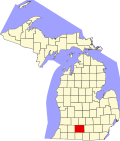History
The Kalamazoo River oil spill occurred in July 2010 when a pipeline operated by Enbridge (Line 6B) burst and flowed into Talmadge Creek, a tributary of the Kalamazoo River. A six-foot break in the pipeline resulted in the largest inland oil spill, and one of the costliest spills in U.S. history. The pipeline carries diluted bitumen (dilbit), a heavy crude oil from Canada's Athabasca oil sands to the United States. Following the spill, the volatile hydrocarbon diluents evaporated, leaving the heavier bitumen to sink in the water column. Thirty-five miles of the Kalamazoo River were closed for clean-up until June 2012, when portions of the river were re-opened. On March 14, 2013, the Environmental Protection Agency (EPA) ordered Enbridge to return to dredge portions of the river to remove submerged oil and oil-contaminated sediment.
Demographics
Historical population| Census | Pop. | Note | %± |
|---|
| 1840 | 10,599 | | — |
|---|
| 1850 | 19,162 | | 80.8% |
|---|
| 1860 | 29,564 | | 54.3% |
|---|
| 1870 | 36,569 | | 23.7% |
|---|
| 1880 | 38,452 | | 5.1% |
|---|
| 1890 | 43,501 | | 13.1% |
|---|
| 1900 | 49,315 | | 13.4% |
|---|
| 1910 | 56,638 | | 14.8% |
|---|
| 1920 | 72,918 | | 28.7% |
|---|
| 1930 | 87,043 | | 19.4% |
|---|
| 1940 | 94,206 | | 8.2% |
|---|
| 1950 | 120,813 | | 28.2% |
|---|
| 1960 | 138,858 | | 14.9% |
|---|
| 1970 | 141,963 | | 2.2% |
|---|
| 1980 | 141,557 | | −0.3% |
|---|
| 1990 | 135,982 | | −3.9% |
|---|
| 2000 | 137,985 | | 1.5% |
|---|
| 2010 | 136,146 | | −1.3% |
|---|
| 2020 | 134,310 | | −1.3% |
|---|
| 2024 (est.) | 133,785 | [6] | −0.4% |
|---|
|
The 2010 United States Census [11] indicates Calhoun County had a 2010 population of 136,146. This is a decrease of -1,839 people from the 2000 United States census. Overall, the county had a -1.3% growth rate during this ten-year period. In 2010 there were 54,016 households and 35,220 families in the county. The population density was 192.8 per square mile (74.4 square kilometers). There were 61,042 housing units at an average density of 86.4 per square mile (33.4 square kilometers). The racial and ethnic makeup of the county was 79.8% White, 10.7% Black or African American, 0.5% Native American, 1.6% Asian, 4.5% Hispanic or Latino, 0.1% from other races, and 2.7% from two or more races.
There were 54,016 households, out of which 31.2% had children under the age of 18 living with them, 45.3% were husband and wife families, 14.6% had a female householder with no husband present, 34.8% were non-families, and 28.8% were made up of individuals. The average household size was 2.44 and the average family size was 2.98.
In the county, the population was spread out, with 24.2% under age of 18, 9.3% from 18 to 24, 24.0% from 25 to 44, 27.7% from 45 to 64, and 14.8% who were 65 years of age or older. The median age was 39 years. For every 100 females there were 95.5 males. For every 100 females age 18 and over, there were 92.5 males.
The 2010 American Community Survey 1-year estimate [11] indicates the median income for a household in the county was $42,921 and the median income for a family was $49,964. Males had a median income of $25,712 versus $18,298 for females. The per capita income for the county was $20,661. About 11.7% of families and 16.2% of the population were below the poverty line, including 23.9% of those under the age 18 and 5.8% of those age 65 or over.
Government and politics
The county government operates the jail, maintains rural roads, operates the major local courts, keeps files of deeds and mortgages, maintains vital records, administers public health regulations, and participates with the state in the provision of welfare and other social services. The county board of commissioners controls the budget but has only limited authority to make laws or ordinances. In Michigan, most local government functions — police and fire, building and zoning, tax assessment, street maintenance, etc. — are the responsibility of individual cities and townships.
Calhoun County is a swing county in presidential elections. Beginning in 1964, it has voted for the winner of the national election every time except in 1976 (instead backing native Michigander Gerald Ford), 2000, and 2020.
Elected officials
(information as of October 2020)
This page is based on this
Wikipedia article Text is available under the
CC BY-SA 4.0 license; additional terms may apply.
Images, videos and audio are available under their respective licenses.



